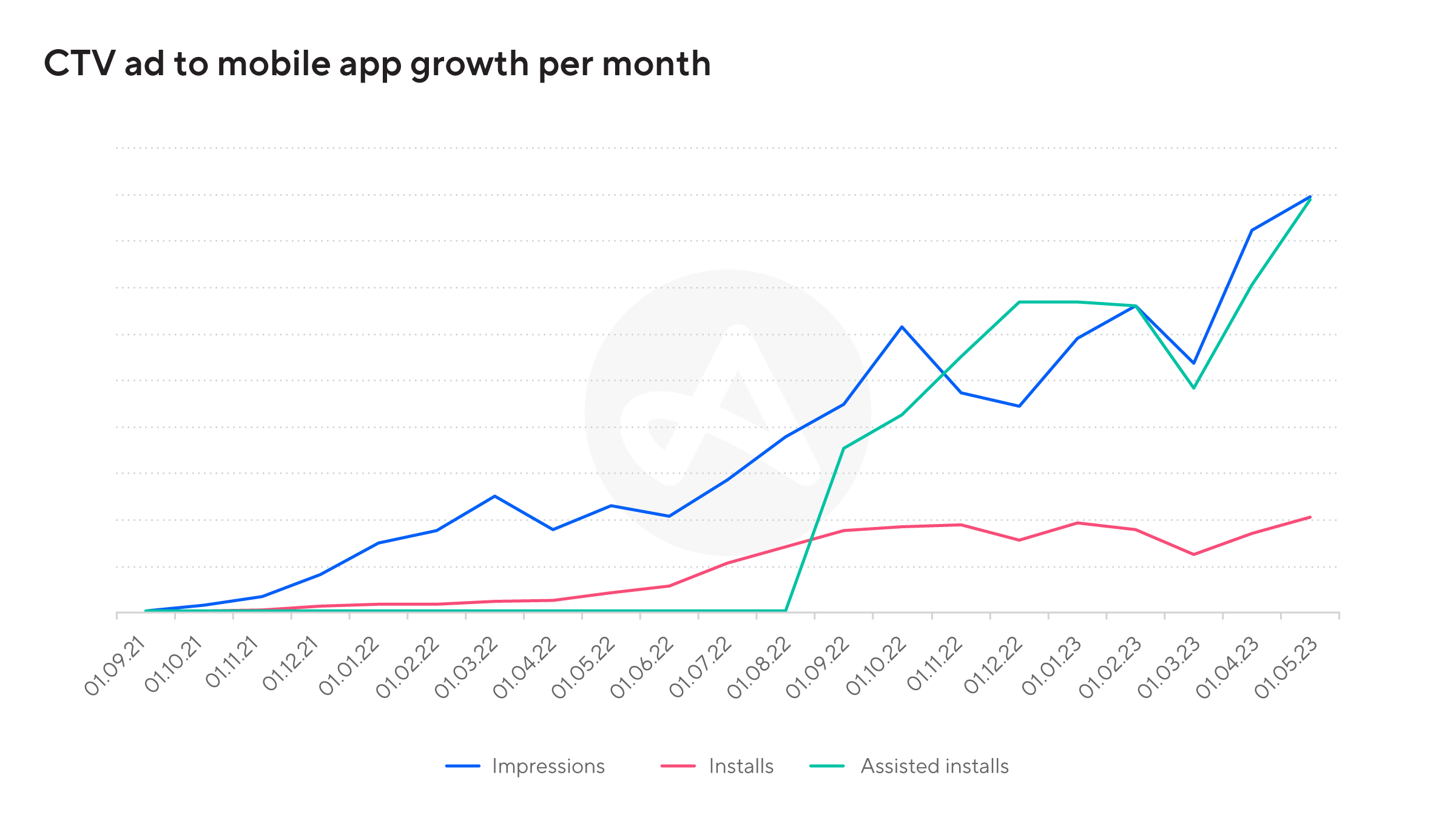Connected TV (CTV): the app marketer’s 5-step guide
The following post is a reflection on the ever-growing and emerging acquisition channel: Connected TV (CTV), written by Yodel Mobile’s Strategic Growth Director, Megan Dean. Megan has been with Yodel Mobile for over eight years, starting out as a media planner and buyer. With her wealth of knowledge of the app acquisition landscape, keep reading to see her thoughts on CTV as an acquisition channel for growing your app, and her guide for maximising its usage. The evolving advertising landscape
The evolving advertising landscape
When I was just starting out in my career, I was lucky enough to gain valuable work experience at a few large, traditional advertising agencies. What always struck me was how much time and effort went into big brand and TV campaigns, but with very little capability to measure the impact of those campaigns.
A few years later, when I was introduced to the concept of app marketing, the methods and tactics resonated with me, particularly because the digital world has always inherently offered more attribution and measurable data.
Every decision was a data-informed decision.
The advertising industry has come a long way since then, and we have seen the development and growth of some major trends in how people interact with both their phones and brands. One of the biggest trends is Connected TV (CTV), which refers to an internet-connected device that is used to watch TV or video content online and has fast become user preference over linear TV (think Apple TV and Roku, for example).

This innovative approach combines the benefits of traditional television advertising with the enhanced targeting capabilities of digital marketing. Additionally, marketers can display ads on streaming services (OTT) on devices such as desktop computers and mobile phones, so the ads are not exclusively served on a CTV device.
The increasing trend of CTV is undeniable, but what are the opportunities and pitfalls of considering CTV alongside some more mainstream app acquisition platforms such as Meta, Google or Apple Search Ads?
Let’s first dive into how CTV ads work...
Making TV a measurable acquisition source
Over the past decade, the way that entertainment is consumed by viewers has shifted dramatically. The standard television set that we knew has been replaced by CTV.
This provides new advertising and marketing opportunities for brands. CTV advertising functions like programmatic advertising and offers all the benefits of internet advertising. Not only that, but it’s an opportunity to drive performance-based brand campaigns on a big screen, where creative is king.
For app owners with an allocated brand and OTT budget, this would be a great opportunity to take your TV budget and liaise with partners with highly relevant inventory. You can engage direct partners such as Amazon, Roku & Hulu, or DSPs such as Teads, Moloco or StackAdapt.
The growth of the CTV market provides brands with new opportunities to grow your app user base.
Here is our 5-step guide if you are considering utilising CTV as part of your wider app marketing strategy:
1. CTV advertising is more accessible than traditional OTT advertising.
You can arguably make your linear-TV budgets go further with CTV.
TV campaigns are traditionally utilised by large brands, because of the significant monetary investment required to run a campaign to such a broad audience for a prolonged period. However, with CTV there are a wide range of networks offering more accessible models, often without minimum budget requirements. This opens the door to small or newly-launched brands who may want to dip their toe in the water, to run these campaigns without having to going all-in on linear TV.
This means you can introduce CTV ads early on in your channel testing strategy alongside the main performance platforms such as Google, Meta and ASA.
2. CTV campaigns are measurable!
While CTV is largely still considered a brand channel, attribution for CTV is a fast-developing area for these types of campaigns. Typically, advertisers are limited to tracking deeper funnel metrics with your CTV ad campaigns, and in the case for app marketers, no CPI attribution. The typical metrics you can measure include:
- Impressions
- VTR (View-through-rate)
- CPM
- Cost Per Completed View (video ad format)
However, measurement for CTV is a growing area. MMP Adjust has launched its AdVision dashboard, which shows incremental impact, installs and assisted installs from CTV. With more visibility on the impact of these campaigns, more and more marketers are starting to incorporate CTV into their performance marketing mix.

* Growth of CTV usage in the last two years. Source: Adjust
Not only that, but unlike traditional TV ads, where insights about campaign performance are received after a month of running, CTV, being a digital platform, allows real-time reporting. This access to data enables advertisers to analyze and adjust optimize and improve their campaigns much more effectively.
3. CTV offers cost-effective advertising and engagement.
CTV advertising allows you to get your ads on the big screen without a hefty price tag. It offers flexibility in selecting a pricing structure, such as cost per metric or cost per view, making it more affordable to reach target audiences for this format. Additionally, compared to other channels like the web or a single device, CTV also has lower impression costs.
With big screen formats, advertisers can take advantage of creatives that have high potential for engagement, including the following formats:
- In-Stream Video Ads: typically, no more than 60s and un-skippable ads served at certain points of the users viewing experience and most similar to linear-TV ads
- Interactive Video Ads: native ads that offer an interactive element like a QR code or content cards that can be highly personalized or localized

With these formats, research conducted by Adweek on the 'Attention Economy' reveals that CTV emerges as an exceptionally cost-effective channel for capturing ad attention, boasting a remarkable cost of only $1.10 per 1,000 seconds (about 16 and a half minutes) of attention. This makes it one of the most efficient platforms ever examined.
4. Effective targeting through CTV.
With data now available on different demographic and behavioural audiences, there is some capability to target your CTV advertising. This may not be as hyper-targeted as a platform like Meta, but offers more options than traditional linear TV.
Creating customised spots for different audiences and testing them on a smaller scale can be a great starting point for building up confidence with this channel before scaling to a greater audience. With algorithms to buy and sell ad space in real time, you are able to use your targeting to reach the right people at the right time.
5. CTV pitfalls to watch out for.
Overall, for brands looking to run brand marketing activity with a bit more of a performance mindset, CTV can be a great option. But as with any advertising, there are some pitfalls to watch out for.
The first step is choosing your CTV partner, which may be an overwhelming task. There are a wide range of partners and networks available through which to run CTV campaigns. Here’s how we recommend you approach your partner search:
- Marketers should do their research when selecting a partner to run through and watch out for resellers who have very little control over the inventory.
- A good place to start can be to go direct to certain streaming platforms, such as Amazon or Peacock, which may have lower reach but will guarantee high quality traffic.
- Another option is to use an AdTech company with a large inventory and data to help you place your campaign in front of the right audiences.
The second pitfall to avoid is spending on fraudulent advertising. As with any network-based campaign or emerging channel, CTV campaigns are at risk of fraud. There have been cases which range from technical issues such as devices not having the capacity to know whether devices are on or off, to fraudsters taking advantage of loopholes by impersonating CTV devices with mobile or other digital devices. As with any campaign, you need to monitor and make sure that the data and attribution look correct and are in line with expected results to monitor for fraud.
While CTV advertising is still a fairly new practice, we will see more and more marketers incorporating this into their marketing mix in the next few years. As attribution technology for CTV continues to improve, and privacy restrictions on mobile continue to strengthen, the benefits and reach offered by CTV will become an attractive proposition.







